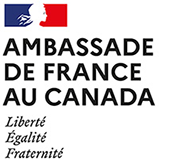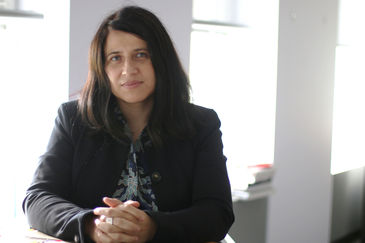- Could you tell us a little about yourself?
My passion for photography dates back to my childhood. I remember these moments where I would dig through piles of family photos that we kept in a trunk. I travelled through time and space, discovering faces and the countries that my family came from: Morocco and Algeria. I was lucky that I got to study at the École national supérieure de la Photographie in France, and then I started to research art history and the history of photography.
I’ve worked in libraries that conserve photos and in photo libraries. I’ve also taught photography, printing, and the history of photo archive management. Before I arrived at the Canadian Photography Institute, I was the Director of Collections at the Société française de photographie, which is the oldest photography organization still active in Europe. I’m happy to still sit on its Board of Directors. The SFP was founded in 1854 and its collections were developed thanks to donations from photographers dating back to the early days of photography. The association collects photographs by Daguerre, Bayard, and Niépce, in addition to the amateur, pictorialist, autochrome, and scientific collections. That’s something that really interests me. I think there are almost as many audiences for photography as there are ways to work with images. This openness to all these approaches to photography—whether artistic, amateur, commercial, or documentary—is the heart of the vision of the Canadian Photography Institute, which is a place to share, collect, and study photography in all its forms. That’s what drew me to it. It’s not just images; I love words too. My latest book will come out on September 27th, through Larousse. It is called Les grands photographes du XXe siècle. We are working with the Institute on a very original book about the Gold Rush. That will be out in October. That’s the subject of one of our three big exhibitions at the CPI. These images were given to us by the Archive of Modern Conflict, which is the Institute’s creative partner.
- You told us about your interest in scientific photography; can you tell us more about that?
I became interested in scientific photography while I was researching meteorological photography, particularly in different observatories. I devoured the scientific literature and the popularization of science of the 19th century.
I had the opportunity to organize an exhibition at the Musée de la main in Lausanne, Switzerland, which was called La preuve par l’image [Images of Conviction]. I worked with scientist/sociologist Francesco Panese, who is also interested in the role of images in the development of scientific knowledge. We wanted to show how photography had been used as proof in science and para-scientific fields. We showcased collections of old and contemporary images from researchers at the polytechnic institutes of Lausanne and Zurich while putting the spotlight on the cryptozoology archives: the science of extinct animals—like the dodo—and extraordinary animals, such as the enigmatic Loch Ness Monster or Bigfoot. You notice that the belief systems are the same and that an image alone doesn’t prove anything.
I had the opportunity to work on this topic again in 2015, when I organized an exhibition at LE BAL in Paris with Diane Dufour. This exhibition was entitled Images à charge: la construction de la preuve par l’image. We decided that it would focus on representations of individual crimes and of crimes against humanity.
Along with scientific photography, there is also the matter of proof and objectivity. What has always captivated me about scientific photography is the typology and inventory process, which often goes hand-in-hand with the emergence of a science.
I’ve always been drawn to this kind of tension between things that are created for art and documentary, scientific, or amateur photography.
What does the CPI do?
The CPI was created in 2015 as a joint project between the National Gallery of Canada, the National Gallery of Canada Foundation, Scotiabank, and the Archive of Modern Conflict collection, the creator of which suggested that we put together collections of exceptional photos. This made it easier to integrate donations and new acquisitions into the collection and helped optimize resource management: the goal is to enrich Canadian culture.
In terms of its infrastructure and its resources, the CPI is an integrated part of the National Gallery and its mission is part of that of the National Gallery, but the CPI focuses on photography in all its forms, rather than art in general. In keeping with the vision of the National Gallery, the CPI helps support the feelings of identity and pride of Canadians regarding the richness of their visual heritage, while making the Gallery a centre for excellence in photography. We are working to diversify our audiences, to integrate communities of photographers, and to bring together people and communities at the museum, in line with and around the publications in order to experience, appreciate, and study photography.
Among our major objectives, the promotion of Canadian photography and research into Canadian photography are priority issues. Attracting and engaging young people is another priority, as is the optimized digitization of our collections; developing and participating in innovative digital projects, and joining the international photo book community, which is so creative.
Is photography is very present in Canada as an art form, compared to France or Europe?
I would say that photography is more and more present in Canada: festivals are asserting their places on the scene, institutions are creating dedicated spaces for their exhibitions, and new prizes are available to help young photographers advance with their career.
One thing is for sure: the status of photographers and authors in Canada is different, compared to Europe and France in particular. Canada looks after Canadian photographers, and strict agreements regulate their payment when their work is on display; when they are invited to events; when they present at a conference, when they publish an image online, on social media networks, or in books… That still seems like a very distant dream for photographers. In France, photographers often have to pay out of their own pockets to be featured at an expo, to produce their work, etc.
You might have had the chance to see an exhibition by André Kunard, who is an associate curator at the CPI: this exhibition pulls off the challenge of displaying 40 years of photography in Canada (1960–2000) in almost as many works from our rich collection. You notice the great diversity of practices, starting with a journalistic style with its fairly small formats. Over time the formats grew larger and started to feature more colour. The culmination of the exhibition is Jeff Wall’s subline Destroyed Room.
What projects do you have coming up with the CPI?
For spring 2018, we are working on an exhibition that will commemorate the 50th anniversary of the collection of the National Gallery. That’ll be curated by Ann Thomas. Also for 2018, Lori Pauli, one of the CPI conservators, is working on a monographic retrospective about British photographer Gustave Rejlander, one of the pioneers of 19th century photography.
We also have a great project in the works with the AGO in Toronto that we will announce soon.
Very soon, on November 2nd, 2017, we will inaugurate—and the opening will be open to everyone—three photo exhibitions sharing the common threads of migration, borders, and territory: fundamental subjects in Canadian identity and culture.
• Our first exhibition is by young Canadian photographer Andreas Rutkauskas, who is exploring the USA-Canada border. He roamed this border for years, generally on foot and with a camera in hand.
• The second exhibition is entitled GOLD AND SILVER: IMAGES AND IMAGINATION OF THE GOLD RUSH. This is a collaboration with Library and Archives Canada. It’s also an opportunity to highlight one aspect of the Archive of Modern Conflict’s recent donation to the CPI about the origins of photography.
Through fascinating and often unprecedented images, the exhibition tells the story of the hopes, dreams, and illusions of an entire generation of explorers who went off in search of gold. This exhibition uses images to take us from the rivers of California to the snowy peaks of the Yukon. It also explores two great moments in the history of photography: that of the influence of the single, cherished image on metal through to the age of multiple images on glass and then on paper.
Portraits were shot in the photographer’s studio, often while the photographer moved around. Miners, with the help of the photographer, cultivated an image of impropriety, creating a provocative image for themselves: in this case, the respectable model was not the bourgeois, but rather the bandit.
This iconography breaks completely with the norms established by daguerreotypes, where people are always shown in the best social position.
In the Yukon, the images are more instantaneous and focus much more on the land and the movements of people.
The last exhibition, Frontera, was developed in collaboration with the FotoMexico photography festival. It brings together eight points of view from contemporary international photographers regarding the topic of the Mexican border. The goal here is to reflect on the border: is it a limit? A passage? Both? The title of the exhibition is Frontera: VIEWS OF THE U.S.-MEXICO BORDER. You’ll see photos from Mexican photographers Pablo López Luz and Alejandro Cartagena alongside photos from Canadian photographers Mark Ruwedel and Geoffrey James, alongside the Swiss Adrien Missika, American Kirsten Luce, and German Daniel Schwarz.
If you had to choose your favourite photo, what would it be?
If I had to choose one photo that’s my favourite at the moment, it would be the one that we call “the lovers”. It’s a ferrotype from the 1860s shot in the studio of an unknown photographer, depicting two young gold hunters posing in front of a painted background. We chose this image for the poster of the Gold and Silver exhibition. These two young explorers are seated and leaning against each other. It seems as though they are very fond of one another. We usually see this in films but rarely in photography, especially at the time. There is something cinematographic in this image. It’s not a portrait and the subject of the photo is not these two characters, but rather what exists between them. I don’t know who this picture was meant for or who kept it, but it is just captivating. It is the cover of our upcoming book Gold and Silver, which will be co-published with RVB Books.

